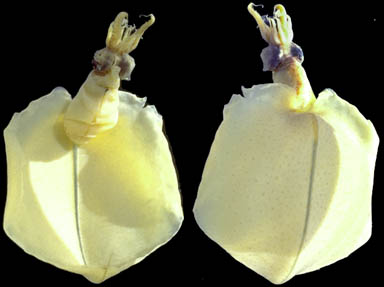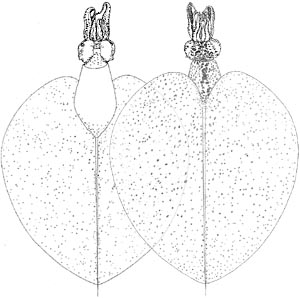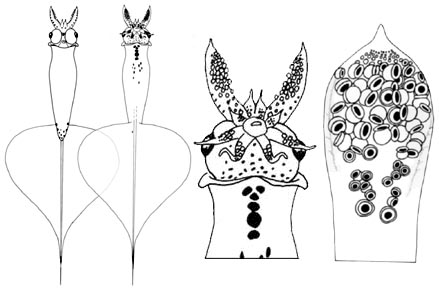Magnapinna pacifica
Pacific bigfin squid
Michael Vecchione and Richard E. YoungIntroduction
Magnapinna pacifica, the type species of the family, was described from three individuals: Two juveniles about 50 mm ML and a paralarva of 19 mm ML. No additional specimens have been reported since the original description.
Diagnosis
A Magnapinna with ...
- proximal-tentacles wider than adjacent arms.
- numerous suckers on proximal-tentacles.
Characteristics
- Arms.
- Proximal-arm suckers biserial distally, in 3 to 4 series at base.
- Distal-arms vermiform.
- Inner sucker rings probably smooth.
 image info
image info image info
image infoFigure. Arms of M. pacifica, holotype, 51 mm ML. Left -Ventral and dorsal views of head and brachial crown. Right - Oral views of arms. A - Arm II. B - Arm III. Drawings from Vecchione and Young (1998).
- Tentacles.
- Proximal-tentacles short, thicker than adjacent arms.
 image info
image info Figure. Ventrolateral view of the brachial crown of M. pacifica, holotype, showing the large size of the proximal-tentacle relative to arm IV. Photograph by R. Young.
- Proximal-tentacle suckers small, in approximately eight series except at base.
- Sucker dentition unknown.
- Distal-tentacles vermiform.
 image info
image info Figure. Filaments of M. pacifica, holotype, 51 mm ML . Left - Lateral view of tentacle-club. Middle - Oral view of tentacle-club. Drawing from Vecchione and Young (1998). Right - Dorsal view of head and brachial crown. Photographs by R. Young.
 image info
image info Figure. Dorsolateral view of the head and brachial crown of M. pacifica, Berry specimen. This specimen had dried out and then been reconstituted. Note the large, broad tentacles and the elongate filaments of the arms which bear suckers in this, presumably, older individual.
- Proximal-tentacles short, thicker than adjacent arms.
- Head
- Large eyes occupy most of head.
- Large eyes occupy most of head.
- Funnel
- Funnel locking-apparatus with oval depression.
image info
Figure. Funnel locking-apparatus of M. pacifica, holotype. Arrow points to funnel lock, insert shows drawing of the same lock. Drawing from Vecchione and Young (1998). Photograph by R. Young.
- Funnel locking-apparatus with oval depression.
- Fins
- Fins very large: Length equal to or greater than squid length from posterior tip of muscular mantle to tip of tentacles.
- Fins terminal.
- Width approximates length.
 image info
image info Figure. Ventral view of M. pacifica, paratype, 49 mm ML (USNM 885787). Photograph from Vecchione and Young (1998) which was found in the archives of S. S. Berry.
- Photophores
- Photophores absent.
- Photophores absent.
- Measurements, mm
Holotype Berry specimen Mantle length 51 49 Muscular mantle length 16 17 Gladius length* 53 52 Fin length 39 40 Fin width 34 41 Head length 5 4 Head width 7 5 Eye diameter 4 3 Arm I, left/right, to terminal sucker 2.3 / 2.4 - Arm II, left/right, to terminal sucker 3.9 / 3.5 - Arm III, left/right, to terminal sucker 2.9 / 2.7 - Arm IV, left/right, to terminal sucker 4.8 / 4.8 - Tentacle, left/right, to terminal sucker 7.1 / 7.4 - Arm I, left/right, terminal filament length 2+ / 1.3+ - Arm II, left/right, terminal filament length 2+ / 2.6 - Arm III, left/right, terminal filament length 2.6+ / 2.9 - Arm IV, left/right, terminal filament length 2.0 / 1.3+ - Tentacle, left/right, terminal filament length 2.2 / - -
Life History
Only a single paralarva is known. It has the following characteristics:- Arms
- Arms short, with suckers in 3-4 series at bases of arms III and IV; otherwise in two series.
- Arm tips bare and attenuate.
- Tentacles
- Tentacles short, broad.
- Suckers in 7-8 series distally, grades into buds.
- Fins
- Muscular mantle overlaps anterior of fins by 15% of fin length.
- Fins extend onto a tail posteriorly.
Figure. Paralarvae of M. pacifica. Left - Ventral and dorsal views, 19.1 mm ML, Hawaiian waters. Middle - Dorsal view of head of same paralarva. Right - Tentacle of same paralarva. Drawings from Vecchione and Young (1998), modified.
Distribution
The holotype was taken off the California coast at a depth between 0 and 200m in a Bongo plankton net. The other juvenile was found in the stomach of the lancet fish Alepisaurus ferox and the paralarva was taken off Hawaii at a depth between 0 and 300 m in a 4 m2 plankton net.
The capture localities are:
- Holotype, 51 mm ML: 33° 49'N, 121° 51'W.
- Juvenile, 49 mm ML; 30° 22'N, 129° 45'W.
- Paralarva, 19.1 mm ML; 21° 20'N, 158° 20'W
Figure. Distribution chart of M. pacifica. White dots indicate capture localities. Chart modified from Vecchione and Young (1998).
References
Vecchione, M. and R. E. Young. 1998. The Magnapinnidae, a newly discovered family of oceanic squids (Cephalopoda; Oegopsida). South African Journal of Marine Science, 20: 429-437.
Title Illustrations
| Scientific Name | Magnapinna pacifica |
|---|---|
| Reference | Vecchione, M. and R. E. Young. 1998. The Magnapinnidae, a newly discovered family of oceanic squids (Cephalopoda; Oegopsida). South African Journal of Marine Science, 20: 429-437. |
| Specimen Condition | Dead Specimen |
| View | Ventral and dorsal |
| Size | 51 mm ML |
| Type | Holotype |
| Copyright | © 1998 |
| Scientific Name | Magnapinna pacifica |
|---|---|
| Reference | Vecchione, M. and R. E. Young. 1998. The Magnapinnidae, a newly discovered family of oceanic squids (Cephalopoda; Oegopsida). South African Journal of Marine Science, 20: 429-437. |
| Creator | K. Hiratsuka Moore |
| View | Ventral and dorsal |
| Size | 51 mm ML |
| Type | Holotype |
| Copyright | © 2004 |
About This Page
National Marine Fisheries Service
Systematics Laboratory
National Museum of Natural History
Washington, D. C. 20560
USA
Richard E. Young
Dept of Oceanography
University of Hawaii
Honolulu, Hawaii 96822
USA
Page copyright © 1998 and Richard E. Young
Citing this page:
Vecchione, Michael and Young, Richard E. 1998. Magnapinna pacifica . Pacific bigfin squid. Version 01 January 1998 (under construction). http://tolweb.org/Magnapinna_pacifica/19449/1998.01.01 in The Tree of Life Web Project, http://tolweb.org/











